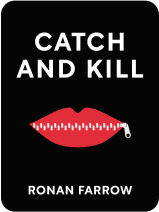

This article is an excerpt from the Shortform book guide to "Catch and Kill" by Ronan Farrow. Shortform has the world's best summaries and analyses of books you should be reading.
Like this article? Sign up for a free trial here .
How did Ronan Farrow end up with The New Yorker? And what made him leave NBC News?
In 2017, Ken Aultetta arranged a meeting between Ronan Farrow and The New Yorker editor David Remnick. Remnick told Farrow that if NBC was unwilling to air his story, The New Yorker would.
Read more about Ronan Farrow and The New Yorker deal.
Ronan Farrow and The New Yorker
After Oppenheim had ordered Farrow and Rich McHugh to cease all contact with sources and potential sources, the story was effectively killed at NBC. But Farrow refused to let it die. So many women had risked so much to share their experiences. This had to come out. If NBC wasn’t going to run with it, Farrow needed to take it somewhere that would. In summer 2017, his mentor throughout the Weinstein story, journalist Ken Auletta (who had nearly cracked the Weinstein case himself back in 2002), brokered a meeting between Ronan Farrow and The New Yorker editor David Remnick.
Remnick was floored when he was presented with the mass of evidence Farrow had against Weinstein: allegations from five women about multiple acts of sexual harassment and abuse, the Gutierrez recording, and corroboration from 16 current and former executives and assistants.
He was even more astounded and outraged to learn that NBC was refusing to air the story or let Farrow speak to more sources. Remnick assured Farrow that if NBC was refusing to air the story, The New Yorker would. He told Farrow to continue his reporting and keep the magazine fully apprised of any new developments. When Ronan Farrow warned New Yorker senior editor Deirdre Foley-Mendelssohn about the potential legal risks of the story, he received the affirmation that he never got from his bosses at NBC: “I don’t know the specific legal risks here. But I don’t think you should cancel things. And you never stop reporting.”
The team at the magazine subjected Farrow’s story to a thorough grilling and fact-checking. Unlike NBC, they believed in the story and wanted to run with it, but they needed to make sure the facts were in order before they faced the inevitable legal retaliation from Weinstein.
The Floodgates Open
Although Weinstein was delighted by NBC’s utter capitulation, he was keenly aware that Farrow’s reporting still existed and could be dusted off and revived at any time by future reporters. He was determined to make sure that all evidence of the story was destroyed root-and-branch.
Accordingly, litigation counsel for the Weinstein Company sent a letter to CAA (the agency representing Farrow), making several extraordinary demands. Among other things, the letter demanded that Farrow hand over all his notes and recordings to NBC, that he surrender the names and contact information of any other news outlets he might be working with, and that he provide written assurance that the reporting had been terminated. The letter also threatened him with a multi-million dollar lawsuit should he publish anything about the Weinstein Company or its employees.
Legal counsel at The New Yorker thought the letter was ridiculous and its legal arguments thin, at best. They were blown away by the sheer audacity of many of the claims it made and urged Farrow to plow ahead with his reporting. So, with the magazine backing him up, he continued to plug away at the story.
By early fall 2017, Farrow had also become aware that the New York Times was also working on a story about Weinstein. After all the work he’d put in, there was now a real danger that his story would be scooped by another outlet. Two respected investigative reporters, Megan Twohey and Jodi Kantor, were on the case for the Times and had been in contact with some of the same sources as Farrow.
Although Farrow was happy that the story now seemed certain to go public (and that the Times would draw some of the backlash from Weinstein), he did not want to see his own efforts go to waste. In late September, Farrow learned that Twohey and Kantor had filed their report and that it was set to go online. The race was now on at The New Yorker to finalize Ronan Farrow’s story and get it out as soon as possible. The team at the magazine began fact-checking and drafting the piece at a furious pace, pulling gruelling hours as they checked and re-checked every source.
Weinstein’s legal team (including the “feminist” attorney and onetime Farrow confidante Lisa Bloom) now directed its threats at both Ronan Farrow and The New Yorker. In a letter to the magazine, the attorneys derided its reporting as “defamatory,” demanded that The New Yorker refrain from publishing the story, and further ordered that they hand over to the Weinstein Company all statements that Farrow had collected from the company’s employees.
They also argued that Farrow harbored personal animus toward Weinstein over the latter’s relationship with Woody Allen (to whom Weinstein had placed a personal phone call, asking Allen to provide dirt on his own son). Even more ludicrously, the letter claimed that Farrow could not be trusted to report on matters of sexual abuse because Farrow’s maternal uncle had been convicted of sexually abusing two boys. They argued that, because Farrow had not publicly denounced this member of his family, he was not credible as a journalist.
The Story Hits
On October 10, 2017, The New Yorker published Ronan Farrow’s piece, “From Aggressive Overtures to Sexual Assault: Harvey Weinstein’s Accusers Tell Their Stories,”. It proved to be a bombshell: within hours of the story going live, Farrow had texts and emails from countless strangers, sharing their own stories of sexual abuse at the hands of figures in government, media, business, and law. Farrow had broken open the dam on an ugly aspect of American life that extended to the highest levels of power.
Overnight, Farrow went from being the guy who NBC unceremoniously tossed out to the journalist everyone wanted to book on their show—including his former employers at NBC. At the same time, the network was petrified at the idea of the public becoming aware of their own complicity in covering up the Weinstein story. After all, the publication of such a groundbreaking piece in The New Yorker by Ronan Farrow, who had so recently been under contract with NBC raised the question, “Why didn’t NBC run with this?”
Pretty soon, media personalities like Jake Tapper and Rachel Maddow were asking the same question. NBC’s public explanation was that, at the time Farrow was working on the story for them, it hadn’t been fully fleshed out and did not meet their journalistic standards to go live. This was, of course, patently absurd. Farrow had on-the-record statements from dozens of Weinstein employees as well as victims, not to mention the Gutierrez recording—all of which he had shown to Noah Oppenheim and Andy Lack.
On an appearance on Maddow’s show, Farrow revealed the truth: that the Weinstein story had been reportable by the time he brought it to NBC and that the network had buried it for other reasons. He had not only exposed the truth about Weinstein, he had exposed his own network’s lies in their efforts to cover it up.

———End of Preview———
Like what you just read? Read the rest of the world's best book summary and analysis of Ronan Farrow's "Catch and Kill" at Shortform .
Here's what you'll find in our full Catch and Kill summary :
- How Ronan Farrow uncovered rampant sexual abuse and assault by Harvey Weinstein
- How NBC tried to intimidate Farrow into killing the Weinstein story
- How the media and legal systems let Weinstein's abuse continue for decades






